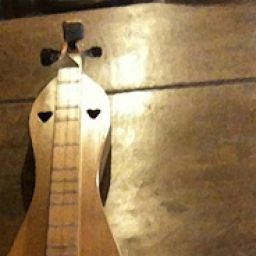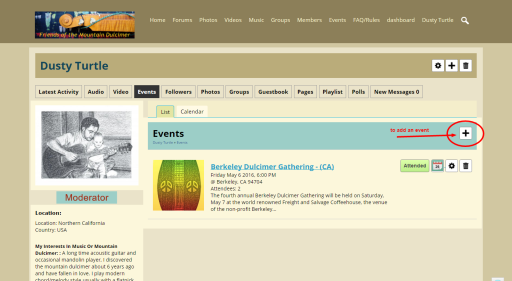Tessie, that's a great old clip of your grandmother. How wonderful that you have that recording to keep your memory of her singing alive.
Leo Kretzner is a great player and a wonderful teacher. I strongly advise working with him. And please tell him I said hello, too. Leo not only plays the dulcimer but really understands music theory and how to teach. You will be in good hands.
If you are playing the chorus beginning on the middle string at the fourth fret tuned DAd, you can also play it beginning on the melody string on the first fret (1-1-3-4-5-5-5-4-3-1). You are playing in Em.
Personally, since I play across all the strings and chord, I would play the song in that key either by tuning to DAd and putting a capo at the first fret or by tuning to GDg, where the melody would start on the first fret of the middle string.
Whether a song is major or minor is determined by the third note of the scale. If the major third is used, the song is in the major key. If the minor third is use the song is in the minor key (unless we're talking the blues, for that is another beast.) Let me explain this first in the key of C. Picture a piano keyboard. If C is the first note of the scale, D is the second, and E is the third. Between the C and the D are two half steps (from C to C# and from C# tto D) or one whole step. Then from D to E we see another two half steps (from D to D# and from D# to E) or one whole step. So a major third is made up of two whole steps. But the minor third of C is Eb, which is made up of one whole step (from C to C# to D) and one half step (from D to Eb).
On the dulcimer fretboard, notice that you have fat and skinny frets. A fat fret represents a whole step and a skinny fret represents a 1/2 step. So on your D string, the second fret represents the major third (two whole steps), an F#. If you want to get a minor third from an open D string, you need that 1-1/2 fret (one whole and one half step), an F.
But elsewhere on the fretboard we can find that pattern of a fat fret and then a skinny fret, which is why you can play the song beginning on the 4th fret of the middle string or the first fret of the melody string. However, the rest of the scale may not correspond to the minor scale. This is where a discussion of modes is necessary, something Ken or someone else is better equipped to handle.
Finally, let me make a comment about the common misconception that keys themselves correspond to a certain vocal range. That is just not the case. Different melodies have different vocal ranges. Some are called "authentic" because the melody falls between the 1st and 8th notes of the scale. But other melodies are called "plagal," and in such melodies the first note of the scale is in the middle of the melody's range (an obvious example is Happy "Birthday"). The point here is not the terminology--which I encourage you to ignore--but the idea that different songs have different ranges, and one song in D might actually be many tones higher than another song in D, depending on the specific tonal range of the melody. So perhaps one song is too low for you to sing in D and feels more comfortable in G, but that will not be the case for every song.
I know this is a lot to take in, but there is a reason why people usually start on the dulcimer playing "Go Tell Aunt Rhody" or "Bile Dem Cabbage Down" rather than other songs. Since I'll be taking my daughter to the pool later, let me use that metaphor. Starting with those basic songs mentioned above is like taking those easy steps into the shallow end of the pool. Starting the dulcimer by asking whether you should tune to D or G, and by stating that you want a 1-1/2 fret, and that you want to play a specific song in a minor key, you are jumping into the deep end. It might seem overwhelming at first, but just try to tread water for now; you'll be doing the butterfly and the Australian crawl soon!





